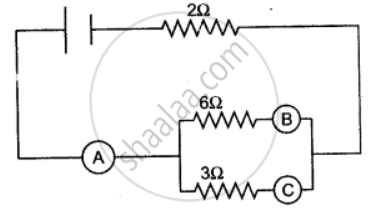Advertisements
Advertisements
प्रश्न
In the figure given below, A, B and C are three ammeters. The ammeter B reads 0.5A. (All the ammeters have negligible resistance.)

Calculate:
(i) the readings in the ammeters A and C.
(ii) the total resistance of the circuit.
उत्तर
(i) P.d. across 6 Ω = P. d. across 3 Ω
Or 6 × 0.5 = 3 × ic
Or ic i.e., current passing through the ammeter C is:
`(6 xx 0.5)/3 = 1.0`ampere
(ii) Here, `1/"R" = 1/6 + 1/3 = 3/6 = 1/2`
or R = 2 Ω
∴ Total ressistance of the circuit = 2Ω + R = 2Ω + 2Ω = 4Ω
∴ Current through A = Current passing through B + current passing through C
= 0.5 + 1.0 = 1.5 ampere
APPEARS IN
संबंधित प्रश्न
Keeping the resistance constant, the potential difference applied across the ends of a component is halved. By how much does the current change?
The V-I graph for a series combination and for a parallel combination of two resistors is shown in Fig – 8.38. Which of the two, A or B, represents the parallel combination? Give a reason for your answer.
The device used for measuring potential difference is
What would you suggest to a student if while performing an experiment he finds that the pointer/needle of the ammeter and voltmeter do not coincide with the zero marks on the scales when the circuit is open? No extra ammeter/voltmeter is available in the laboratory.
A current of 0.2 A flows through a conducting wire for 5 minutes. How much charge will flow?
A 10 m long wire of a particular material is of resistance 5Ω What will be the resistance if the wire is doubled itself.
Conceptual question.
A bird sitting on a high power electric line is still safe. How?
What is the measure of the work done on the unit positive charge to bring it to that point against all electrical forces?
Find the potential difference required to flow a current of 300 mA in a wire of resistance 20 Ω.
